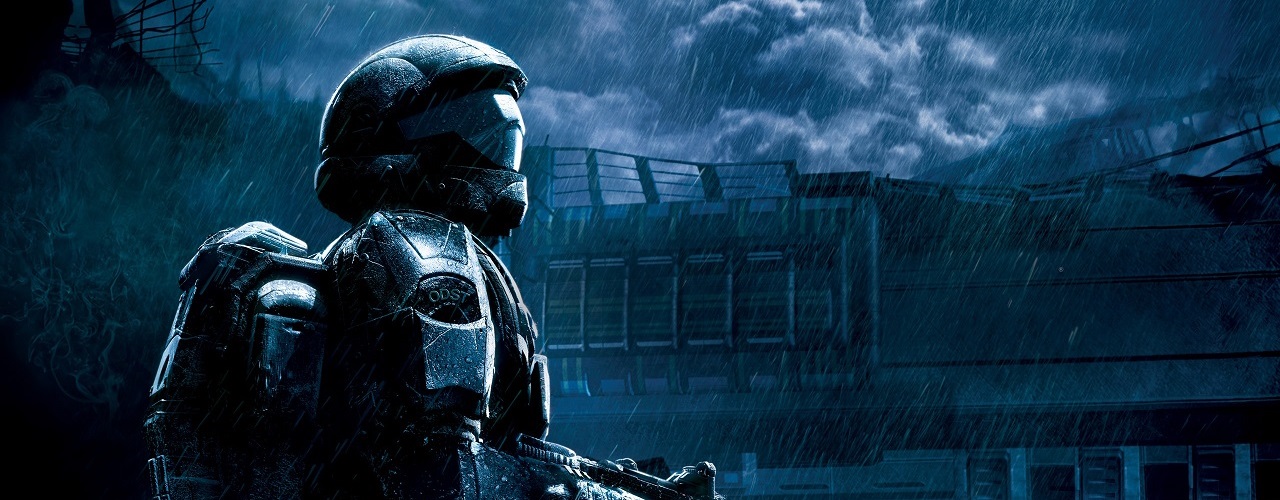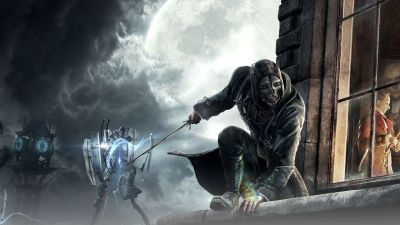Halo: ODST represented a turning point for Bungie.
While the studio had been obsessed with continuing the adventures of Master Chief since the original game’s release back in 2001, ODST - originally intended to be a slice of DLC for Halo 3, before being hived off into a standalone release - sees players inhabiting the shoes of a relative everyman.
The core gameplay of the series remains much the same: you’re still restricted to a two-weapon limit, the game is still broken down into a number of discrete levels, while the series’ lore - an overwrought space opera detailing the war between two opposing factions - remains intact.
That said, in ODST it’s important to note that you’re not Master Chief: you’re a grunt. An elite grunt, sure - but a grunt nonetheless.
This difference manifests itself in a number of ways. You’re significantly more vulnerable, for a start - lacking the recharging shield that the series is known for, which will see you scavenging for health packs. You run slower, jump lower, and you’re altogether weaker, making battles more fraught than you might be used to if you’re a series veteran.
You’ll still wield Needle Guns, take down Elites and Hunters and plant grenades on enemy vehicles; but whereas in previous games those opponents sometimes felt like cannon fodder, in ODST they feel like real threats. You’re certainly not powerless - though you’re still limited to two weapons, and the enemies you face will be familiar from previous series entries - but ODST feels more intimate.
A large part of that is due to the game’s fantastic musical score. While prior games in the series opted for a bombastic orchestral soundtrack reminiscent of Wagner, with heavy percussion throughout, ODST‘s soundtrack is dominated by saxaphones, flutes and a mournful ambiance which perfectly reflects the loss and suffering that New Mombassa has been subjected to. The result is a complete change of atmosphere, illustrating just how important the soundtrack is to the series. Zimmerman-esque bombast is replaced instead by licks of a sax which bring to mind nothing less than Vangelis’ work on Blade Runner, and vien the neon-soaked, rain-slicked streets, it’s hard to believe that’s a coincidence. It works though. Boy, does it work - saturating each stage, each area in a thick miasma of melancholy which presents the series in a way that it’s never been presented before. Stoic, almost apocalyptic, Halo: ODST is a game which breaks from the blockbuster pacing of the series proper to present a darker, more personal tale. Some might think that the absence of the Master Chief is downside; in reality, by focusing on a far more human set of characters, Bungie crafts a tale that is perhaps no deeper than John-117’s exploits, but feels more believable. You care about this crew, and it’s hard not to become invested in their story as you slowly unpick what has happened to them since the fateful launch from your orbiting mothership.
ODST casts you as an ordinary soldier, dropped into an extra-ordinary situation. Taking place concurrent with the events of Halo 2, it’s your job to explore the streets of New Mombassa and obtain valuable intel which will aid humanity’s ongoing fight against the Covenant.
While Halo is known as much for its bright color palette as it is for its genre-redefining take on the FPS, ODST sees Bungie taking a more somber approach to proceedings. Your time in the main hub is dominated by a color scheme that is all muted blues and purples; rain is constantly lashing down, while a jazz-infused soundtrack stands in stark contrast to the orchestral bombast seen in other installments. More than anything, its atmosphere evokes the melancholic mood of Ridley Scott’s Blade Runner. The playable flashbacks bring back much of the bright color that has come to define the series, but for the most part the visual design reflects the bleak tale that plays out throughout the campaign. In fact, it’s Blade Runner that is evoked repeatedly throughout your playthrough, far more so than previous games in the series.
Overall, the graphics in ODST show a significant improvement over those seen in Halo 3. While both games use the same engine, character and facial animations are notably more advanced, and textures are sharper throughout. The environments, too, are more detailed while the lighting effects remain impressive even now, nearly 5 years on. That said, it’s still runs on the same engine as Halo 3, so issues such as sub-HD resolution remain, while there’s plenty of aliasing on show. But the art direction does a lot to hide those limitations.
While the game is still relatively linear, in between levels you are free to explore the war-torn streets of New Mombassa. Doing so will throw up various audio logs, fleshing out the story behind the city’s invasion. While most of the game’s districts are visually indistinct from each other, the feeling that you are inhabiting a doomed metropolis is persistently reinforced. In other games, constant back-tracking is a nuisance; in ODST, it helps to establish your environment as a coherent place - a place that is both believable and under siege.
Your ultimate objective is to determine the fate of the rest of your team. You do this by locating various artifacts throughout the world via the use of your visor. Locate these items and you’ll trigger playable flashbacks, explaining what happened during the time between the game’s opening cutscene and the moment in which you are given control of your character. These snippets of history eventually build to a crescendo, an action-packed finale for which the series is so well known.
At times, ODST feels like a Greatest Hits compilation; it mixes up expansive vehicle-based sections, tightly-woven corridor runs, and instances where you simply need to hold your ground and fend off the enemy, evoking plenty of memories of previous games. Thankfully, however, the much-maligned Flood don’t make an appearance. While you’re not playing as the Master Chief, it still feels like a Halo game - albeit one with a far different atmosphere from what you are used to.
Typically for the series, the game ends with an extended firefight and a prolonged vehicle section. It’s engaging though, and even for people who aren’t fans of the franchise, ODST represents a highly satisfying slice of shooter gameplay. Encounters are taut and strategic - aided by the two-weapon limit - while the murky visual atmosphere and downbeat score never ceases to inspire a melancholic air to proceedings.
In terms of multiplayer, ODST introduced the Firefight mode. Essentially a riff on Gears of War‘s Horde mode, Firefight sees players teaming up and fending off wave after wave of Covenant forces. It returned in Halo: Reach, but was sadly absent in Halo 4. It’s a shame, because Firefight is a hugely enjoyable addition, highlighting the skills of Bungie’s map designers. Meanwhile, co-op remains as enjoyable as ever, though some of the atmosphere is lost. The campaign aims - and succeeds - to evoke a feeling of isolation, but it’s a feeling which is diluted when playing alongside a partner. We highly recommend playing it solo before bringing others along for the ride.
The campaign’s running time is relatively short. A determined player can easily complete it in around 6 hours or less, though finding all of the audio logs hidden about the city will likely double that figure. The short length betrays the game’s origins - ODST was never intended to be a retail release, after all. But that’s just fine; It contains enough atmosphere and personality to stand alone, and not playing as the Master Chief enabled Bungie to craft a game that feels more human. In ODST you’re not a super-soldier roaming the galaxy; you’re just a regular grunt trying to do his best and make a difference - and save his comrades in the process.
While on the face of things ODST‘s additions to the series’ formula are minor, Bungie crafted a bite-sized slice of gaming which remains as refreshing now as it did at the time of the title’s original release. And despite the game’s origins as DLC, it stands on its own two feet as a worthy experience.
Sure, it’s not as drastic a departure from the series formula as Halo Wars or Spartan Assault, but ODST brings something else beyond simply being yet another tale of humans vs. aliens.
Simply put, it brings soul.


